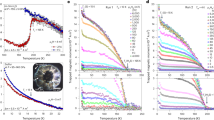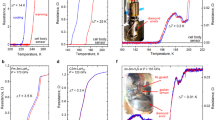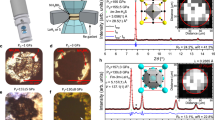Abstract
It has recently been reported that hydrogen-rich materials under high-pressure trap magnetic flux, a tell-tale signature of superconductivity (Minkov et al., Trapped magnetic flux in hydrogen-rich high-temperature superconductors, Ref. 1). Here, we point out that under the protocol used in these experiments the measured results indicate that the materials don’t trap magnetic flux. Instead, the measured results either are experimental artifacts or originate in magnetic properties of the sample or its environment unrelated to superconductivity. Together with other experimental evidence analyzed earlier, this clearly indicates that these materials are not superconductors.
Similar content being viewed by others
Avoid common mistakes on your manuscript.
1 Introduction
Following the paper “Conventional superconductivity at 203 kelvin at high pressures in the sulfur hydride system”, published in 2015 [2], several other hydrogen-rich materials under high pressure have been reported in recent years to be high-temperature superconductors based on observed drops in resistance versus temperature [3,4,5,6,7,8,9,10,11,12,13,14,15,16,17,18,19]. Many more such materials have been determined to be conventional high-temperature superconductors based on theoretical evidence [20,21,22,23,24,25]. However, little magnetic evidence has so far been provided in support of the claims of superconductivity [2, 26,27,28,29], and what evidence does exist has been strongly called into question [30,31,32,33].
In particular, these materials show no trace of magnetic flux expulsion, i.e., the Meissner effect, when cooled in the presence of a magnetic field [2, 26, 27]. They also apparently are able to screen very large applied magnetic fields [28]. This has been interpreted as indicating that the materials are “hard superconductors” with very strong pinning centers that prevent both flux penetration and flux expulsion [26,27,28]. We have argued that if that is the case the materials should also trap large magnetic fields [34], and that observation of flux trapping would provide definitive evidence that the materials can sustain persistent currents, hence are indeed superconductors [34].
Experiments aimed at detecting flux trapping were recently performed by Minkov et al. and the results analyzed and reported in Ref. [1]. Ref. [1] interprets the measured data as clearly indicating that the materials are superconductors. Instead, we analyze here the information presented in Ref. [1] and conclude that it proves the absence of superconductivity in these materials.
2 Experimental Protocols
The flux trapping experiments on sulfur hydride (\(H_3S\)) [1] were performed under zero-field-cooling (ZFC) conditions for 13 values of applied field ranging from 0 to 6T, and under field cooling (FC) conditions for one field value only, 4T. The results for both protocols for field 4T were reported to agree [1]. In the ZFC protocol, the sample was cooled to low temperatures in zero magnetic field, a magnetic field was then applied and gradually increased to reach value \(H_M\); then after 1 h, the external field was gradually decreased to zero; then, the resulting magnetic moment was measured with a SQUID magnetometer.
Figure 1 shows the experimental data and a theoretical fit to the data given in Ref. [1]. Note in particular that the measured magnetic moment rises linearly from zero when the applied field exceeds the threshold value \(H_p\) both for the experimental data and for the theoretical fit.
The experimental results were reportedly analyzed in Ref. [1] assuming the Bean model [36] controls the behavior of fields and currents in the material. From the experimental results, Ref. [1] inferred the parameters:
\(H_p=0.042T\)=threshold value of the applied field where it begins to penetrate the sample at low temperatures. Assuming demagnetization \(1/(1-N)=8.5\), this implies a lower critical field value \(H_{c1}=0.36T\).
\(H^*=0.835T\)= minimum applied field that reaches the center of the sample (called “full penetration field”), with assumed sample diameter and height \(d=85 \mu m\), \(h=2.5 \mu m\).
The measured moment was found to increase with magnetic field \(H_M\) up to a maximum value of approximately \(m_s=15.9\times 10^{-9}Am^2\) for \(T=30K\) when the applied magnetic field was \(\sim 1.7T\equiv H_M^{sat}\) or larger. Following the Bean model, Ref. [1] concluded that
from which the value of \(H^*\) was extracted.
The theoretical fit performed in Ref. [1] assumed the magnetic moment is given by (with \(j_c\) the critical current)
so that \(r(H_p)=d/2\), \(r(2H^*+H_p)=0\).
3 Our Analysis
Just as Ref. [1], we assume the validity of the Bean model. However, we disagree that Eqs. (2) and (3) used by the authors of [1] are the proper way to calculate the trapped magnetic moment under ZFC conditions. Instead, we argue that Eq. (2) is the proper way to calculate the trapped moment under FC conditions, provided Eq. (3) is replaced by
for \(H_M<H^*+H_p\), \(r=0\) for \(H_M>H^*+H_p\), with \(H_p = 0\). This is illustrated in the left panels of Fig. 2. For ZFC conditions instead, the diagrams shown in the right panels of Fig. 2 apply. For that case, the magnetic moment is given by
where, for \(H_M<H^*+H_p\)
For \(H^*+H_p<H_M<2H^*+H_p\), \(r_1\) is given by Eq. (6) and \(r_2=0\), and for \(H_M>2H^*+H_p\), \(r_1=r_2=0\).
Expected trapped magnetic moment versus magnetization field \(H_M\) for the parameters assumed in Ref. [1] under FC and ZFC protocols. For small \(H_M\) the dependence is linear (quadratic) for FC (ZFC) protocols. The experimental points are also shown
Figure 3 shows what these expressions predict for the trapped magnetic moment versus magnetization field \(H_M\) for the parameters assumed [37] in Ref. [1]. Most importantly, the moment rises from zero linearly under FC conditions and quadratically for ZFC conditions. As seen in the inset, for small fields, the ZFC moment is very much smaller than the FC moment and in stark disagreement with the experimental observations.
The experimental results of Ref. [1] are actually well fit by our FC calculation for all values of the magnetization field \(H_M\) if we take the value of \(H^*\) to be twice as large as inferred in Ref. [1], i.e. \(H^*=1.67 T\). This is shown in Fig. 4. We conclude that this agreement is accidental, since the experimental protocol was ZFC for all but one experimental point [1].
Expected trapped magnetic moment versus magnetization field \(H_M\) assuming \(H^*\) is twice the value inferred in Ref. [1], i.e., \(H^*=1.67 T\), compared to the experimental points. Remarkably, the experimental points obtained with the ZFC protocol are actually fitted by the calculation assuming FC
In order to try to fit the low-field ZFC experimental data to the ZFC calculation, we would have to take a much smaller value of \(H^*\). Figure 5 shows the results for \(H^*=0.2 T\), chosen to fit as well as possible the low-field data. In addition to not fitting the low-field data very well, the higher field data deviate strongly from the theoretical ZFC curve. For this assumed value of \(H^*\) the trapped moment saturates for \(H_M^{sat}=0.44T\) (Eq. (1)), in clear contradiction with the experimental data that show no saturation until \(H_M>1T\).
4 Discussion
Is it possible that under the ZFC protocol of the experiment with the field \(H_M\) applied for 1 h, the field could penetrate sufficiently so as to mimic the FC protocol? It is not possible, because Ref. [1] also measured the rate of flux creep and there was negligible flux creep over a 1-h period even at temperatures as high as 165K. Also, according to the NRS experiment [28] the flux didn’t penetrate over times substantially larger than 1 h.
Therefore, the experimental results of Ref. [1] shown in Fig. 1 of this paper are incompatible with the interpretation that the magnetic moment observed originates in flux trapping. If the magnetic moment had originated in flux trapping, it would rise quadratically from zero as function of the magnetization field \(H_M\) under the ZFC conditions of the experiment, not linearly as observed. Therefore, the experiment indicates that there is no flux trapping in this material, \(H_3S\). As argued in Refs. [32, 34], if the material doesn’t trap flux, and in addition it does not expel flux, then the material is not a superconductor.
The question then arises, what is the origin of the magnetic moments measured in Ref. [1] shown in Fig. 1? We suggest they are either experimental artifacts associated with the experimental apparatus used (SQUID magnetometer) or magnetic moments of localized spins originating either in the sample or in the diamond anvil cell environment (gasket, etc.). It is also possible that the measurements could signal unexpected collective magnetic behavior of hydrogen-rich materials under high pressure, as suggested in Ref. [38].
To confirm the results of our analysis, we suggest that it would be of interest to repeat the measurements of Ref. [1] under FC conditions. We expect that the results will be similar to the results under ZFC conditions, in contradiction with what is expected from trapped flux shown in Figs. 3 and 4, namely a marked difference between FC and ZFC behavior, and consistent with the hypothesis that the origin of the magnetic moments measured is localized spins rather than delocalized supercurrents. We suggest that it would also be informative to perform these experiments using FC and ZFC protocols for a known hard superconductor and verify the expected qualitatively different behaviors shown in Figs. 3 and 4.
Finally, we would like to point out that the interpretation of the measurements of magnetic moment of Ref. [1] as originating in flux trapping with \(H^*\sim 0.8T\) appears to be in contradiction with the magnetic moment measurements presented in Ref. [26]. For example, according to the former (see our Fig. 2 top right panel) for an applied field \(H\sim H^*/4=0.2T\), the magnetic field should still be excluded from more than \(75 \%\) of the sample even at temperature \(T\sim 100K\) (see Fig. 1c of [1]). Instead, the magnetic moment measurements shown in Fig. 3a of Ref. [26] indicate that the diamagnetism has essentially disappeared at that point.
References
Minkov, V.S., Ksenofontov, V., Budko, S.L., Talantsev, E.F., Eremets, M.I.: Trapped magnetic flux in hydrogen-rich high-temperature superconductors (2022). https://arxiv.org/abs/2206.14108arXiv:2206.14108
Drozdov, A.P., Eremets, M.I., Troyan, I.A., Ksenofontov, V., Shylin, S.I.: Conventional superconductivity at 203 kelvin at high pressures in the sulfur hydride system. Nature 525, 73-76 (2015). https://www.nature.com/articles/nature14964
Drozdov, A.P., Eremets, M.I., Troyan, I.A.: Superconductivity above 100 K in PH3 at high pressures. https://arxiv.org/abs/1508.06224arXiv:1508.06224 (2015)
Drozdov, A.P., et al.: Superconductivity at 250 K in lanthanum hydride under high pressures. Nature 569, 528-531 (2019). https://www.nature.com/articles/s41586-019-1201-8
Hong, F., et al.: Superconductivity of Lanthanum Superhydride Investigated Using the Standard Four-Probe Configuration under High Pressures. Chin. Phys. Lett. 37, 107401 (2020). http://cpl.iphy.ac.cn/10.1088/0256-307X/37/10/107401
Somayazulu, M., et al.: Evidence for superconductivity above 260 K in lanthanum superhydride at megabar pressures. Phys. Rev. Lett. 122, 027001 (2019). https://journals.aps.org/prl/abstract/10.1103/PhysRevLett.122.027001
Grockowiak, A.D., et al.: Hot Hydride Superconductivity above 550 K. Front. Electron. Mater. (2022). https://www.frontiersin.org/articles/10.3389/femat.2022.837651/full
Kong, P.P., et al.: Superconductivity up to 243 K in the yttrium-hydrogen system under high pressure. Nat Commun 12, 5075 (2021). https://www.nature.com/articles/s41467-021-25372-2
Troyan, Y.A., et al.: Anomalous high-temperature superconductivity in \(YH_6\). Adv. Mater. 2006832 (2021). https://onlinelibrary.wiley.com/doi/full/10.1002/adma.202006832
Snider, E., et al.: Synthesis of Yttrium Superhydride Superconductor with a Transition Temperature up to 262 K by Catalytic Hydrogenation at High Pressures. Phys. Rev. Lett. 126, 117003 (2021). https://journals.aps.org/prl/abstract/10.1103/PhysRevLett.126.117003
Semenok, D.V., et al.: Superconductivity at 161 K in thorium hydride \(ThH_{10}\): Synthesis and properties. Materials Today 33, 36-44 (2020). https://www.sciencedirect.com/science/article/abs/pii/S1369702119308077
Zhou, D., et al.: Superconducting praseodymium superhydrides. Science Advances 6, eaax6849 (2020). https://advances.sciencemag.org/content/6/9/eaax6849/tab-pdf
Semenok, D.V., et al.: Superconductivity at 253 K in lanthanum-yttrium ternary hydrides. Materials Today 48, 18 (2021). https://www.sciencedirect.com/science/article/abs/pii/S1369702121001309?via%3Dihub
Snider, E., et al.: Room-temperature superconductivity in a carbonaceous sulfur hydride. Nature 586, 373 (2020). https://www.nature.com/articles/s41586-020-2801-z
Chen, W., et al.: High-Temperature Superconducting Phases in Cerium Superhydride with a \(T_c\) up to 115 K below a Pressure of 1 Megabar. Phys. Rev. Lett. 127, 117001 (2021). https://journals.aps.org/prl/abstract/10.1103/PhysRevLett.127.117001
Hong, F., et al.: Possible superconductivity at \(\sim 70K\) in tin hydride \(SnH_x\)under high pressure. Materials Today Physics 22, 100596 (2022). https://www.sciencedirect.com/science/article/pii/S2542529321002571
Chen, W., et al.: Synthesis of molecular metallic barium superhydride: pseudocubic \(BaH_{12}\). Nature Comm. 12, 273 (2021). https://www.nature.com/articles/s41467-020-20103-5
Ma, L., et al.: High-Temperature Superconducting Phase in Clathrate Calcium Hydride \(CaH_6\)up to 215 K at a Pressure of 172 GPa. Phys. Rev. Lett. 128, 167001 (2022). https://journals.aps.org/prl/abstract/10.1103/PhysRevLett.128.167001
Li, Z.W., et al.: Superconductivity above 200 K discovered in superhydrides of calcium. Nat Commun 13, 2863 (2022). https://www.nature.com/articles/s41467-022-30454-w
Semenok, D.V., et al.: On Distribution of Superconductivity in Metal Hydrides. Curr. Opinion Solid State Mater. Sci. 24, 100808 (2020) and references therein
Pickard, C.J., Errea, I., Eremets, M.I., Superconducting Hydrides Under Pressure. Ann. Rev. Cond. Matt. Phys. 11, pp 57-76 (2020) and references therein. https://www.annualreviews.org/doi/10.1146/annurev-conmatphys-031218-013413
Flores-Livas, J.A., et al.: A perspective on conventional high-temperature superconductors at high pressure: Methods and materials. Physics Reports 856, 1-78 (2020). https://www.sciencedirect.com/science/article/pii/S0370157320300363
Boeri, L., Bachelet, B.: Viewpoint: the road to room-temperature conventional superconductivity. J. Phys. Cond. Matt. 31, 234002 (2019). https://iopscience.iop.org/article/10.1088/1361-648X/ab0db2/meta
Quan, Y., Ghosh, S.S., Pickett, W.E.: Compressed hydrides as metallic hydrogen superconductors. Phys. Rev. B 100, 184505 (2019). https://journals.aps.org/prb/abstract/10.1103/PhysRevB.100.184505
Zurek, E., Bi, T.: High-temperature superconductivity in alkaline and rare earth polyhydrides at high pressure: A theoretical perspective. J. Chem. Phys. 150, 050901 (2019). https://aip.scitation.org/doi/full/10.1063/1.5079225
Minkov, V.S., et al.: Magnetic field screening in hydrogen-rich high-temperature superconductors. Nat Commun 13, 3194 (2022). https://www.nature.com/articles/s41467-022-30782-x
Eremets, M.I., et al.: High-temperature superconductivity in hydrides: experimental evidence and details. J Supercond Nov Magn 35, 965 (2022). https://link.springer.com/article/10.1007/s10948-022-06148-1
Troyan, I., et al.: Observation of superconductivity in hydrogen sulfide from nuclear resonant scattering. Science 351, 1303 (2016). https://science.sciencemag.org/content/351/6279/1303
Huang, X., et al.: High-temperature superconductivity in sulfur hydride evidenced by alternating-current magnetic susceptibility. Nat. Sci. Rev. 6, 713 (2019). https://academic.oup.com/nsr/article/6/4/713/5487527
Hirsch, J.E., Marsiglio, F.: Meissner effect in nonstandard superconductors. Physica C 587, 1353896 (2021). https://www.sciencedirect.com/science/article/pii/S0921453421000794
Hirsch, J.E., Marsiglio, F.: Absence of magnetic evidence for superconductivity in hydrides under high pressure. Physica C 584, 1353866 (2021). https://www.sciencedirect.com/science/article/abs/pii/S0921453421000496?via%3Dihub
Hirsch, J.E., Marsiglio, F.: Clear evidence against superconductivity in hydrides under high pressure. arXiv:2110.07568 (2021). https://arxiv.org/abs/2110.07568. to be published in MRE
Hirsch, J.E.: Faulty evidence for superconductivity in ac magnetic susceptibility of sulfur hydride under pressure. National Science Review 9, nwac086 (2022). https://academic.oup.com/nsr/article/9/6/nwac086/6583297?login=false
Hirsch, J.E., Marsiglio, F.: Flux trapping in superconducting hydrides under high pressure. Physica C 589, 1353916 (2021). https://www.sciencedirect.com/science/article/pii/S092145342100099X
Reference [1] states “The trapped magnetic moment was determined as the difference between the measured magnetic moment after magnetization cycle and the residual magnetic moment, which arises from the body of the miniature DAC above the corresponding \(T_c\) (see Supplementary Figure 1).” Therefore a subtraction is involved in the magnetic moment data presented in Ref. [1]
Bean, C.P.: Magnetization of High-Field Superconductors. Rev. Mod. Phys. 36, 31 (1964). https://journals.aps.org/rmp/abstract/10.1103/RevModPhys.36.31
In this and the following figures we have assumed the value of Hp from Ref. [1] for ZFC for our FC calculations. However, Hp should be zero for FC
Hirsch, J.E.: Ferromagnetism in metallic hydrogen. Phys. Lett. A 141, 191-195 (1989). https://www.sciencedirect.com/science/article/pii/0375960189907871; Superconductivity and hydromagnetism. Physica B 163, 291-298 (1990). https://www.sciencedirect.com/science/article/pii/092145269090194Y
Acknowledgements
FM was supported in part by the Natural Sciences and Engineering Research Council of Canada (NSERC) and by an MIF from the Province of Alberta. We are grateful to the authors of Ref. [1] and particularly V. Minkov for clarifying information.
Author information
Authors and Affiliations
Corresponding author
Additional information
Publisher’s Note
Springer Nature remains neutral with regard to jurisdictional claims in published maps and institutional affiliations.
Rights and permissions
Open Access This article is licensed under a Creative Commons Attribution 4.0 International License, which permits use, sharing, adaptation, distribution and reproduction in any medium or format, as long as you give appropriate credit to the original author(s) and the source, provide a link to the Creative Commons licence, and indicate if changes were made. The images or other third party material in this article are included in the article's Creative Commons licence, unless indicated otherwise in a credit line to the material. If material is not included in the article's Creative Commons licence and your intended use is not permitted by statutory regulation or exceeds the permitted use, you will need to obtain permission directly from the copyright holder. To view a copy of this licence, visit http://creativecommons.org/licenses/by/4.0/.
About this article
Cite this article
Hirsch, J.E., Marsiglio, F. Evidence Against Superconductivity in Flux Trapping Experiments on Hydrides Under High Pressure. J Supercond Nov Magn 35, 3141–3145 (2022). https://doi.org/10.1007/s10948-022-06365-8
Published:
Issue Date:
DOI: https://doi.org/10.1007/s10948-022-06365-8









